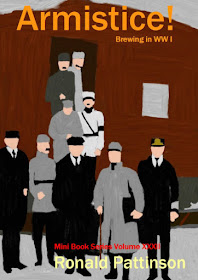I rise just before nine. No rush has been my motto this trip.
The first thing I do is to ring reception to ask if I can check out later. I get a delay until 1 PM. That'll do. I've learnt that you have to ask for stuff. What's the worst that could happen? They could say no.
When I check in for my flight, I’m offered an upgrade to business class for 402 euros. Bit too rich for me, sadly. Though the thought of a flatbed is extremely tempting.
Time for some crap TV and lazing around in my trollies. What fun. I also polish off a couple of bottles of homebrew I was given. Leftover competition beers. I’m always wary of taking homebrew on a flight.
I realise that I'm on the 14th floor. But it jumps from 12th to 14th. So I'm really on the 13th floor. Weird how superstition still has a hold.
The plan for today is elegant in its simplicity: dump my bags in the hotel and wander down to
Cambridge Brewing for a pint or 38.
It’s hot. Uncomfortably hot. Maybe sitting inside wasn’t the best decision as there’s no airco, only fans.
I remember meeting Todd Alstrom when I was over here with the family. We struggled to walk through the snow and ice I may have to move outside where at least there’s a breeze.
I’ve ordered a House Lager. Just 4.5%. But I did have quite a bit of hotel whiskey earlier. I don’t want to get too mad quite yet. My flight is after 8 PM.
House Lager 4.25% ABV
Cold. I’m happy about that. And not crazy. I’m definitely going off crazy beers unless they’re Imperial Stout. Or Imperial Mild.
It’s cool just to hang out for a bit with no aim, other than having a few beers. Back to the work shit tomorrow. Though where it will be, I’m not quite sure. All this shit I need to get done as in a week I’ll be in Madrid doing something I don’t understand.
Odd being probably the most prolific beer writer. Yet not a professional. As many assume I am. I need a fucking agent to sort the financial shit out.
Been really on top of the notes this trip. Both the scribbled stuff in the pub and electronic notes back in my hotel. I think I’m getting the hang of this. Finally.
Why do I feel so at home in the US? Easy. It was my home for 18 months. I know how shit works here. I made a conscious decision in 1987 to leave the US. Now I feel myself wishing six months or a year over here. Probably long enough to put me off again – as I remember all the reasons. Like hooking up with an old girlfriend and remembering why it all fell apart in the first time around. Wouldn’t stop me giving it another go, mind. The US, I mean, not an old girlfriend.
Fuck, the brewery is close to the bar here. With nothing inbetween. Just saw a brewer climbing into a mash tun just 5 metres away.
Wing Suit 4.5% ABV
Session IPA with rye. Fuck, that’s cloudy. I’d have sent it back a couple of years ago. But I guess anything goes now. It smells like the mango and orange juice mix I used to drink in Melbourne. Just cloudier. Weirdly savoury in the mouth. I’m dead confused.
I had a weird and very complicated dream this morning involving a murder disguised as suicide and confusion over pills. Yes, that is with a double “L”. I never did manage to understand what was going on. Which is sort of a metaphor for my life.
“Didn’t you just murder someone?” I asked someone who knocked at my door.
“Yes.”
Just weird enough not to be really scary. The victim looked like someone I worked with in Leeds in the 1980s. Not totally convinced by the murderer’s attempts to recreate realistic blood splatter. And why was my niece Jackie running down the cycle path on all fours?
Why do I write? I always have since I was a child. Sort of a compulsion. And who I am. Being a writer – other than hanging around on the dole – was the only thing I ever aspired to. For a long time, I never thought it would happen. Then I discovered writing about beer and pubs.
I need some food. Only had a few mouthfuls of yesterday’s leftover sandwich. What to have? Chicken quesadilla or a fried chicken sandwich? After changing my mind about a dozen times, I go for the latter.
The sandwich isn’t bad. And handy for later. Don’t want to rely on the food on the plane. It’s often shit.
Back at the hotel, I retrieve my bags and get a cab. Amazingly, this one seems to take me by the most direct route to the airport. There’s a first. Boston’s taxis must be the worst in the First World. Maybe in all three worlds.
As I’ve some time before boarding, I have one double Jim Beam, no ice, in a bar. Just the one. Out of a sense of tradition.
With my pushing on boarding I’m soon sinking into my seat. The one next to me is handily unoccupied. Perfect for dumping my stuff on. I watch a little stuff on the entertainment system. But not for long. I need to get a good kip. Because I’ll be working as soon as I get home.
I soon drift off into a surprisingly deep sleep.
Cambridge Brewing Company
1 Kendall Square,
Cambridge,
MA 02139.
Tel: +1 617-494-1994
https://www.cambridgebrewingcompany.com/





















